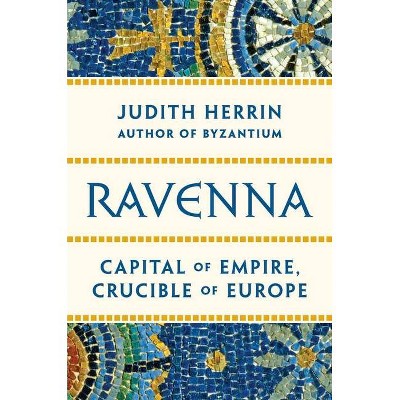Ravenna - by Judith Herrin (Hardcover)

Similar Products
Products of same category from the store
AllProduct info
<p/><br></br><p><b> Book Synopsis </b></p></br></br><p><b>A riveting history of the city that led the West out of the ruins of the Roman Empire</b> <p/>At the end of the fourth century, as the power of Rome faded and Constantinople became the seat of empire, a new capital city was rising in the West. Here, in Ravenna on the coast of Italy, Arian Goths and Catholic Romans competed to produce an unrivaled concentration of buildings and astonishing mosaics. For three centuries, the city attracted scholars, lawyers, craftsmen, and religious luminaries, becoming a true cultural and political capital. Bringing this extraordinary history marvelously to life, Judith Herrin rewrites the history of East and West in the Mediterranean world before the rise of Islam and shows how, thanks to Byzantine influence, Ravenna played a crucial role in the development of medieval Christendom. <p/>Drawing on deep, original research, Herrin tells the personal stories of Ravenna while setting them in a sweeping synthesis of Mediterranean and Christian history. She narrates the lives of the Empress Galla Placidia and the Gothic king Theoderic and describes the achievements of an amazing cosmographer and a doctor who revived Greek medical knowledge in Italy, demolishing the idea that the West just descended into the medieval Dark Ages. <p/>Beautifully illustrated and drawing on the latest archaeological findings, this monumental book provides a bold new interpretation of Ravenna's lasting influence on the culture of Europe and the West.</p><p/><br></br><p><b> Review Quotes </b></p></br></br><br>The book is absolutely gorgeous, with magnificent colour reproductions of Ravenna's churches and mosaics. Relics of an age that seems almost impossibly remote, they are the foundations on which modern Europe stands.<b>---Dominic Sandbrook, <em> Sunday Times</em></b><br><br>Herrin's study and its admirable illustrations are well worth readers' attention . . . . An informative and enjoyable book.<b>---Catharine S. Brosman, <i>Chronicles Magazine</i></b><br><br>Longlisted for the Cundill History Prize, McGill University<br><br>Shortlisted for the Wolfson History Prize, Wolfson Foundation<br><br>A masterwork of scholarship and sharp intelligence.<b>---Neal Ascherson, <i>Red Pepper</i></b><br><br>Shortlisted for the London Hellenic Prize, The Hellenic Centre<br><br>Judith Herrin's Ravenna sparkles like the city's world-heritage mosaics . . . [this] sweeping social and cultural history is presented in easily digestible sections and augmented with lavish illustrations.<b>---Michael Champion, <i>Australian Book Review</i></b><br><br>[T]ake [Judith] Herrin's book slowly. It's not a skimmer. There's a lot to absorb. A careful, patient read best reveals the book's richness.<b>---Brian T. Allen, <i>National Review</i></b><br><br>Winner of the Pol Roger Duff Cooper Prize<br><br>Winner of the PROSE Award in European History, Association of American Publishers<br><br>A sweeping and engrossing history . . . an accessible narrative that brings to life the men and women who created the city during this period and who fashioned its hybrid Christian culture of Latin, Greek and Gothic elements. The narrative is periodically elevated by discussions of the city's most famous attractions and its glorious churches, brilliantly illustrated in the book's 62 color plates. It is also enlivened by recurring digressions on daily life in the city at each phase in its history.<b>---Anthony Kaldellis, <i>Wall Street Journal</i></b><br><br>[E]minently worth reading. The colour plates are so sumptuous that the Ravenna mosaics fairly glow on the page. History teaches us that it is on the margins that the greatest change often occurs. Ravenna was on such a margin. Now, perhaps for the first time, the city emerges triumphant from the shadow of the so-called Dark Ages.<b>---Ian Thomson, <i>The Spectator</i></b><br><br>Bold. . . . elegantly argue[d].-- "New Yorker"<br><br>Judith Herrin explains in her lively, startling book, Ravenna really did deserve 'the most noble' title bestowed by this anonymous admirer. From its origins as a refuge in a dying empire, it went on to host kings and prelates, physicians and lawyers--and ultimately help shape Europe.-- "The Economist"<br><br>[<i>Ravenna</i>] is absolutely gorgeous, with magnificent colour reproductions of Ravenna's churches and mosaics. Relics of an age that seems almost impossibly remote, they are the foundations on which modern Europe stands.<b>---Dominic Sandbrook, <i>The Times</i></b><br><br>Beautifully illustrated, impeccably researched and accessibly presented, it traces Ravenna's career as the capital of the Roman empire in the west. . . . Buildings are also brought to life alongside the people who built and used them. . . . It is this linking of tangible remains and historical record that is the book's great strength.<b>---Jonathan Harris, <i>BBC History Magazine</i></b><br><br>Herrin tells the changing story of Ravenna as it unfolds from the end of the fourth century to the ninth in a series of short, accessible sections with the aid of luscious illustrations.<b>---Averil Cameron, <i>History Today</i></b><br><br>Judith Herrin's book [<i>Ravenna</i>] explains by recounting the city's life from 402, when it became the capital of the Roman Empire in the West, to 751, when the Lombards took over. The story is not, she emphasises, one of decline, but of rebirth, for Ravenna established what European Christendom could become. . . . By the time we can easily visit Ravenna the city again it should be with the advantage of having read Ravenna the book.<b>---Christopher Howse, <i>The Telegraph</i></b><br><br>Aficionados of early medieval history--and of course Ravenna itself--will learn much from Herrin's work.-- "Kirkus Reviews"<br><p/><br></br><p><b> About the Author </b></p></br></br><b>Judith Herrin</b> is professor emeritus in the Department of Classics at King's College London. Her books include <i>Byzantium: The Surprising Life of a Medieval Empire</i>, <i>Women in Purple: Rulers of Medieval Byzantium</i>, and <i>The Formation of Christendom</i> (all Princeton). She lives in Oxford, England.
Price History
Cheapest price in the interval: 25.99 on October 22, 2021
Most expensive price in the interval: 25.99 on November 8, 2021
Price Archive shows prices from various stores, lets you see history and find the cheapest. There is no actual sale on the website. For all support, inquiry and suggestion messagescommunication@pricearchive.us



















